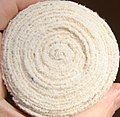| Instrument | Uses |
|---|
| Stethoscopes | used to hear sounds from movements within the body like heart beats, intestinal movement, breath sounds, etc. |
| Reflex testing hammer (padded) | to test motor reflexes of the body |
| Sphygmomanometer(Blood pressuremeter) | to record the patient's blood pressure |
| A thin beam electric torch | to see into the eye, body's natural orifices, etc., and to test for pupillary light reflex, etc. |
| A watch / stopwatch | used in recording rates like heart rate, respiratory rate, etc.; for certain tests of hearing |
| A measuring tape | for size measurements |
| Tongue Depressor | for use in oral examination |
| A weighing machine | to record the weight |
| Tuning forks | to test for deafness and to categorize it |
| Kidney dish | as a tray for instruments, gauze, tissue, etc. |
| Bedpan | for patients who are unconscious or too weak to even sit up of walk to the toilet to defecate |
| Thermometer | to record the body temperature |
| Gas cylinders | supply of oxygen, nitrous oxide, carbon dioxide, etc. |
| Oxygen mask or tubes | delivering gases up to the nostrils to assist in oxygen intake or to administer aerosolized or gaseous drugs |
| Vaporizer | to produce vapors |
| Instrument sterilizers | Used to sterilize instruments in absence of an autoclave |
| Dressing drums | storage of gowns, cotton, linen, etc. |
| Nebulizer | to produce aerosols of drugs to be administered by respiratory route |
| Positive pressureventilator | to assist or carry out the mechanical act of inspiration and expiration so that the patient who can not respire on his / her own may respire; it is a component of "life support" |
| Cardioverter /Defibrillator | to correct arrhythmias of the heart or to start up a heart that is not beating |
| Dialyser | to remove toxic materials from the blood that are generally removed by the kidneys; used in case of renal failure |
| Rubber catheter | to drain and collect urine directly from the bladder (primary use); also to act as a makeshift oxygen tube, etc. |
| Syringe of different sizes and needles | for injections and aspiration of blood or fluid from the body |
| Canula | a kind of a needle that is used to create a permanent pathway to a vein (or artery) for the purpose of repeated injections or infusion of intravenous fluids |
| Transfusion sets | used to transfuse blood and blood products |
| Sucker | for sucking up blood or secretions) |
| Gastrointestinal tubes[3] | |
| •Nasogastric tube | used for nasogastric suction (or at times introduction of food or drugs). vide link |
| •Stomach tube | A tool used for feeding. |
| •Levin's tube | a plastic catheter introduced through the nose and used in gastric intubation for gastric decompression or gavage feeding. |
| •Kehr's "T" tube | urinary |
| •Infant feeding tube | -do-; for infants |
| Spectacles | for protection of the eyes or for refractive error correction |
| Enema set | to passively evacuate the rectum of faeces; vide link |
| Bandage | to cover and protect certain areas of the body such as recent injury |
| Pipettes or droppers | to measure out doses of liquid, specially in children |
| Graduated spoons | to measure out doses of liquids |
| Ophthalmoscope | to look at the retina |
| Otoscope | to look into the external ear cavity |
| Endoscope | to look inside the oesophagus, stomach, upper intestines, bile duct, larynx, trachea, bronchi-through the mouth; anal canal, rectum, colon- through anus; used mainly in Surgery or by surgical consultants |
| Proctoscope | to look inside anal canal and lower part of the rectum |
| Linen | for dressing and draping |
| Beds, bottle stands, etc. | |
| Gauze, cotton,antiseptics, glovesetc. | |























No comments:
Post a Comment
Note: only a member of this blog may post a comment.